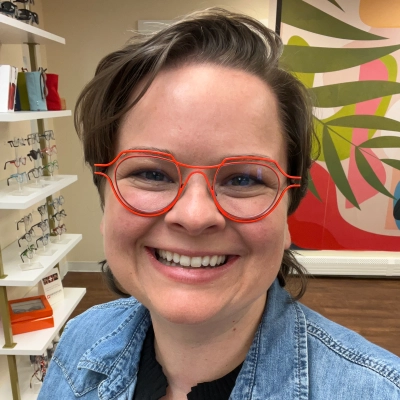6 Difficult Frame Fitting Challenges and Solutions for Opticians"
Opticians face a myriad of complex challenges when fitting frames for clients with unique needs. From addressing severe facial pain to accommodating facial prosthetics, the art of frame fitting requires innovative solutions and precise techniques. This blog post explores six difficult frame fitting scenarios and the ingenious approaches opticians use to ensure comfort, functionality, and style for every client.
- SwissFlex Solution for Severe Facial Pain
- Customizing Nose Pads for Asymmetrical Faces
- Balancing High Prescriptions with Rimless Frames
- Innovative Frame Fitting for Facial Prosthetics
- Precise Positioning of Progressive Lenses
- Adapting Frames for Hearing Aid Users
SwissFlex Solution for Severe Facial Pain
A client had severe facial nerve pain with all but the lightest frames. A dry eye diagnosis was forcing her out of contact lenses. We opted for drill mount brand SwissFlex, which contains no metal components and is very lightweight. I used OptiCampus.com's calculators to select an appropriate lens size and shape, given that the prescription was -5.00. Her pupillary distance was narrow, so I used the child-size bridge, reducing the edge thickness by another 1-2mm. I chose a long temple option and fit it as convertible rather than skull style, adjusted high to keep weight off the tops of her ears. She is now able to wear them all day without triggering a headache, which was our measure of success!

Customizing Nose Pads for Asymmetrical Faces
Adjusting nose pads for asymmetrical facial features can be a tricky task for opticians. Each person's face is unique, and some have more pronounced differences between the left and right sides. This asymmetry can cause glasses to sit unevenly, leading to discomfort and poor vision.
Skilled opticians use various techniques to customize nose pads, ensuring a proper fit for each individual. They may adjust the angle, position, or even the size of the pads to achieve balance. For the best results, consult with an experienced optician who can tailor your glasses to your specific facial structure.
Balancing High Prescriptions with Rimless Frames
Accommodating high prescriptions in rimless frames presents a significant challenge for opticians. The stronger the prescription, the thicker the lenses need to be, which can be difficult to incorporate into the minimalist design of rimless frames. Opticians must carefully select lens materials that are both thin and strong enough to support the prescription.
They also need to consider the placement of the drill holes to ensure the lenses are secure and properly aligned. Balancing aesthetics with functionality is crucial in these cases. If you have a high prescription and desire rimless frames, discuss your options with a knowledgeable optician to find the best solution.
Innovative Frame Fitting for Facial Prosthetics
Fitting frames for patients with facial prosthetics requires a delicate and innovative approach. Opticians must work closely with the patient to understand their specific needs and limitations. The frame must be stable and comfortable while accommodating the prosthetic device. This often involves custom modifications to the frame, such as adjusting temple arms or creating specialized nose pads.
Opticians may need to collaborate with prosthetists to ensure the glasses and prosthetic work together seamlessly. The goal is to provide both clear vision and a natural appearance. If you or someone you know uses a facial prosthetic and needs glasses, seek out an optician with experience in this specialized area.
Precise Positioning of Progressive Lenses
Addressing lens positioning for progressive wearers is a complex task that requires precision. Progressive lenses have different areas for distance, intermediate, and near vision, making proper alignment crucial. Opticians must consider the patient's head posture, eye dominance, and daily activities when fitting these frames.
The frame's size and shape also play a significant role in determining the effectiveness of the progressive lenses. Incorrect positioning can lead to discomfort, eyestrain, and reduced visual acuity. To ensure optimal vision and comfort, schedule a thorough fitting session with an optician experienced in progressive lenses.
Adapting Frames for Hearing Aid Users
Adapting frames for individuals with hearing aids poses unique challenges for opticians. The goal is to create a comfortable fit that doesn't interfere with the hearing aid's function. Opticians must consider the size and placement of the hearing aid when selecting and adjusting frames. They may need to modify temple arms to prevent them from pushing on the hearing aid or causing feedback.
In some cases, specialized frames designed to work with hearing aids may be recommended. The right combination of glasses and hearing aids can greatly improve a person's quality of life. If you wear hearing aids and need new glasses, consult with an optician who has expertise in this area for the best results.

